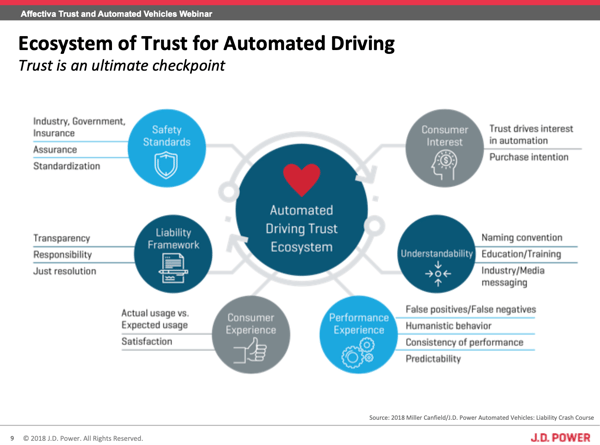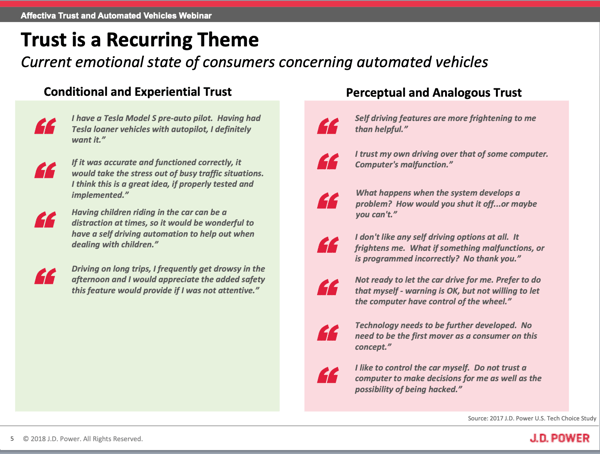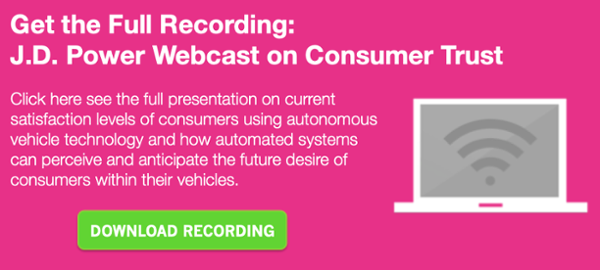
From product development to user experience to the liability framework, trust is a critical checkpoint in the various stages of the automated driving ecosystem. To ensure adoption, consumers must trust that these systems are not only safe and reliable, but intuitive to use. So what is the best way to build trust for those using automated vehicles by choice, and those interacting with them by chance?
Earlier this month, Affectiva hosted Kristin Kolodge, Executive Director of Driver Interaction and HMI at J.D. Power for a webcast around how various Advanced Driver Assistance Systems (ADAS) technologies are performing, according to the voice of the consumer. The webcast focused on current satisfaction levels of consumers using autonomous vehicle technology, how consumers interact with the technology (including how it can assist in accident-avoidance), understanding what consumers find annoying within ADAS systems, and how automated systems can perceive and anticipate the future desire of consumers within their vehicles.
During the webcast, Kristin Kolodge identified a number of takeaways that OEMs and Tier-1 suppliers must consider when developing consumer-friendly experiences within their vehicles. Here are some themes, or “laws,” that Kolodge spoke to during her presentation:
#1 Trust is Critical in Building Automation
For automated vehicles, there currently a chicken and egg situation: "Do consumers trust the technology, or do they need to experience the technology first before they can formulate any concepts of trust?" Kolodge comments that at J.D. Power, she sees a very tight correlation between the concept of trust versus interest in the technology—and so that interest is the first step before considering a purchase. So to create a product that consumers want, trust is an important element to address, as trust builds interest—and it has to be in that order. This discernible, consistent and repeatable pattern has been validated with J.D. Power, data, and is seen across different generations and global regions.
Regarding trust and experience, once consumers start to experience technology, their formulations and thoughts regarding the technology will quickly shift. Now what direction they will shift is determined on the type of experience that they have. Additionally, sometimes trust can be gained from others experience. For example, Kolodge notes that generationally there are very significant differences between a Gen Z person’s level of trust in automated vehicles versus a Baby Boomer—in fact, they are almost at completely separate ends of the spectrum. But watching someone else's experience can modify their thinking, which is an opportunity to influence their perceptions.
Understand the Role of Trust in the Varying Details of Automation
From a consumer point-of-view, Kolodge shared a number of slides around the level of trust around automated vehicles. J.D. Power asked questions of consumers around the globe their thoughts around a fully automated self-driving vehicle. This would be considered a Level 4 / 5 vehicle, where the vehicle is in full control and really that driver is more of a passenger.
There are stark differences across different regions regarding the level of trust. Most positively slanted towards trust is the country of China, where the large majority of those surveyed indicated “I probably would, or I definitely would trust a fully-automated self-driving vehicle.” When looking at the United States and Germany, there are some very strong similarities where the countries are both biased more towards “I definitely would not trust a fully-automated self-driving vehicle,” To be able to understand these reasons and distinctions, that's where consumers were asked to provide a bit more detail:
#2 Trust is Built on Positive Experiences
The state of the market today isn’t quite in the fully automated vehicle state: but from a production readiness perspective, the market is in the advanced driver assistance system (ADAS) state. The Level 1 / 2 vehicles of today is where consumers are starting to see a bit more technology development, which is starting to creep into the Level 3 state for automation.
A portion of Kolodge’s research conducts a technology experience index study for vehicles that are on the road today. J.D. Power then examines the user experience with these technologies (a large portion of which are ADAS) and a higher percentage of consumers that actually have ADAS in their vehicles is increasing year-over-year basis. Kolodge notes seeing double digit increases in technologies like forward collision warning, lane keeping, adaptive cruise control, blind spot monitoring and warning.
In some cases, manufacturers are making these pieces of equipment standard rather than offering as premium features. Consumers are also seeking out these technologies, because when asked if any of their specific ADAS technologies that they had on their vehicle had helped them avoid a crash, 56% of the respondents said yes, they had an experience where ADAS technology helped them avoid a crash within the first 90 days of ownership. So in just 3 months, these people have already received this very strong perceived benefit from ADAS. And as a result, there are very strong levels of satisfaction with these technologies and a very high desire to want these technologies again in their next vehicle.
#3 Trust is Fragile: Takes Time to Build and Can Degrade Quickly
There are a couple of red flags that are coming up with technology: and that is an element that is really impeding on this concept of trust. Specifically for the lane-keeping and centering technologies that are out there, J.D. Power had asked which ADAS technologies consumers considered “annoying or bothersome,” such as their blind spot monitoring or adaptive cruise control features. Kolodge found that lane keeping and centering in particular is 3x as annoying or bothersome as any of the other ADAS systems.
This level of annoyance is causing a level of dissatisfaction as a result, and stresses the importance of understanding what the consumers are experiencing on a day-to-day basis. Depending on the severity and the person, this type of experience might cause someone to swing to the "I definitely don't trust this technology" end of the spectrum, and they might turn the feature off as a result. Not only is trust lost, but they would not gain the safety benefits that we know are possible and intended with each of these assisted technologies. Kolodge urges that car companies recognize that the consumer’s experience with these technologies today will impact what they want tomorrow.
User interfaces are also critical to building and maintaining consumer trust—and user confusion can degrade that trust. Considering the perspective of the consumer: names are not standardized, so adaptive cruise control in one vehicle may be intelligent cruise control somewhere else. It might also be smart, cooperative, or interactive: and then the associated acronym is also not standardized.
Expanding on this, user confusion also surrounds how these different technologies operate, and the constraints in which they operate. So that adaptive cruise control system for one brand may work at any upper speed, but might stop at 20 miles per hour. Some systems might take the speed down to the speed of the vehicle immediately in front of it. Other systems will stop completely, then start again. Then there are variations on each of these. Some of this understanding comes from distinctions across manufacturers, but as a general rule consumers need to understand at a high level how their adaptive cruise control works.
The Bottom Line:
To recap, trust is critical to building interest in automation, in that it is inherent to starting the conversation about integrating this technology into our everyday lives. It’s important for car companies to understand consumer perceptions about automated vehicles. Consumers are also reliant on positive experiences with automation to build trust with these systems. Trust is also fragile, as it must be earned every day with high degree of accuracy.

At the conclusion of the webcast, we also posed to Kolodge a question around flipping the conversation from consumer trust in automated systems to how the cars themselves can trust humans. In Affectiva's world, we’ve started this conversation with regard to driver monitoring: that is, detecting if a driver is distracted or nodding off in an effort to increase road safety. She concluded that this question, while it feels a bit backwards, is a very responsible one—and this two-way dialogue around trust is going to be very relevant going forward. Especially as the industry is in a state of transition between whether the vehicle is in a situation that it cannot handle and recognizes that needs to pass back control to the driver. Yet, there are some instances where the vehicle may not want to pass back to a driver: maybe the driver has fallen asleep, and is in no way ready to take back control because doing so may put the driver in even more danger as a result. Same in the reverse situation - a driver should be able to take control of a car if it is not functioning properly. Trust will ultimately come from a system of checks and balances to create a symbiotic relationship between human driver and autonomous vehicle technologies.
Missed this webcast featuring J.D. Power? See the full presentation with the above insights and more - download the recording here.








